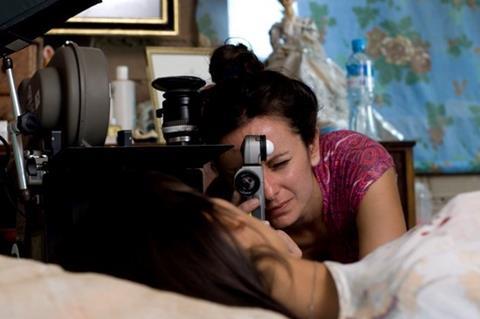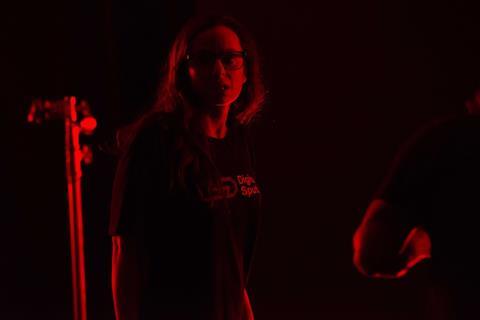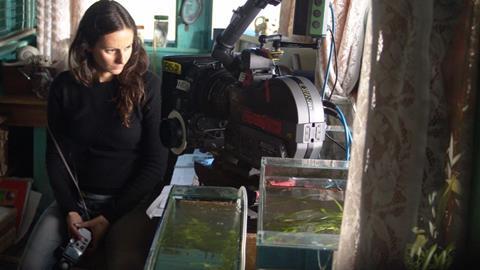The filmmaker’s principal job is tell a story but the conventions of narrative can be a straitjacket for those like cinematographer Natasha Braier who believes in experimenting.
“I consider myself more an emotional poet than a narrator, in a way, so I tend to gravitate to the filmmakers who also have that approach,” says Natasha Braier ASC ADF. “You can be more poetic with the image and let the viewer complete the picture.”

The Argentine cinematographer has tended toward edgy or lyrical material for directors including Sebastián Lelio, Lynne Ramsey and Nicolas Winding Refn.
“I’m attracted to someone with a strong visual personality because I feel with them that I have the freedom to do something more visual and poetic and less tied to conventional storytelling,” Braier says.
She’d made up her mind to be a cinematographer by her late teens. An early interest in photography translated to a passion for film and after her family relocated from Buenos Aires to Barcelona when she was 18, Braier began to study for a career by taking a Masters at the National Film and TV School in Beaconsfield, UK.
“We were encouraged to take 16mm cameras out at the weekend and shoot whatever wanted,” she tells IBC365. “We had all the resources to experiment with but on an artistic level I felt like an alien there. Perhaps I was too experimental. I felt a degree of frustration at the time but looking back, it was an amazing foundation.”
- Read more: Craft leaders: Ben Davis, Cinematographer
She graduated with a showreel and started to look for an agent. “The first year was not so easy, there wasn’t much work. I kept doing lots of short films for not much money. Then the network of connections that you’ve built up over the years starts growing and people start getting proper jobs. I did about five shorts a year and survived on shooting commercials and music videos.”
Her break into features came with Glue a coming of age drama shot in Patagonia and directed by Alexis Dos Santos, with whom she had made several shorts at Film School. The film won awards at film festivals in Rotterdam and Buenos Aires and was praised for its visually striking look.
“I’m attracted to someone with a strong visual personality because I feel with them that I have the freedom to do something more visual and poetic,” Natasha Braier
That led Braier to shoot two films in 2006: En la ciudad de Sylvia directed by Catalan art house director José Luis Guerín, and XXY directed by Argentine Lucía Puenzo, which won Best Film at the Cannes Film Festival Critic’s Week.
“After that I came back to London and was lucky to work with one of my favourite British directors, Shane Meadows. Somers Town was initially meant to be a short film but ended up a feature.” Largely shot in black and white the film won the Michael Powell Award at the Edinburgh IFF in 2008.
She went to Lima to shoot La Teta Asustada (The Milk of Sorrow) directed by Claudia Llosa which addressed the fears of abused women during Peru’s recent history. It became the country’s first Oscar nominated picture (for Best Foreign Film) and Braier spent a period travelling there afterwards.
“Sometimes I might choose a project that’s going to take me to live in a country for a few months so that I can really get to experience a culture and a way of seeing the world from the inside.”
Braier’s reputation from her days at the NFTS as a “revolutionary anarchist Argentinian” brought her to the attention of former student Lynne Ramsey : “People said we were both rebels.”

The director made contact with the budding DP and asked her to lens short film Swimmer which Ramsey made for the 2012 London Olympics.
Ramsay sent Braier a treatment for the film, along with a compilation of music she wanted to use and reference images as a starting point.
“The treatment was a piece of art in itself, with poetry and links to click so I could listen to these British songs she wanted to use. This was quite impressionistic, based on feelings.”
Neon Demon
Perhaps the apotheosis of this approach to date is Braier’s co-creation with Danish director Winding Refn on concept horror Neon Demon in 2016.
“I accepted the job without reading the script because I respected Nicolas as an artist as someone committed to taking risks,” she says. “That is important to me too. I’m not interested in safety. I want to improve myself and express myself and get out of my comfort zone as an artist without fear of failure.
“Whatever that script was, I was going to have a very interesting journey.”
Superficially about the perceived shelf-life of feminine beauty, it would be fair to say Neon Demon caused uproar among critics even by the standards of its provocateur director (Pusher, Only God Forgives). The story has Elle Fanning’s 16-year-old ingénue model go to LA and is first shocked then corrupted then consumed by Hollywood’s haute couture.
The Telegraph dubbed it the most offensive film of the year for being “openly ridiculous” in its blood-drenched portrayal of necrophilia and stylised body horror, at the same time praising “its polished to a glistening marble sheen.” It horrified Cannes audiences too, which is exactly what Refn intended.
“Nic is dealing with very current issues but in a poetic and abstract way,” Braier defends. Unfortunately, a lot of people didn’t get it. Personally, I found the process of working with him really liberating. It re-awakened the anarchist side of my personality.”
- Read more: John Mathieson, Cinematographer
Rather than being dictated by budget, the film’s low $5 million cost allowed them the freedom to experiment. Braier’s bold approach is evident in its vivid colour palette which alternate from blue to lilac and turquoise to bright pink and blood red.
“Shooting chronologically allowed us to discover the movie’s visual language as we went along,” she explains. “As the movie becomes more insane and more surreal, I found myself more and more able to reflect that visually and to let go of all conventions of narration.
“There is still a storyline that you are submitting to, but it was liberating to be free of having to follow certain rules. I’m very grateful to Nic for letting me experiment and get out of my comfort zone without fear of failure.”
Honey Boy
Braier’s latest project is Honey Boy, directed by Alma Har’el and written by and starring Shia LaBeouf about a child actor’s relationship with his hard-drinking father.
“I was drawn to this really profound and powerful story of healing and finding your identity, which are perhaps themes which I’ve returned to again and again in my work. The story is Shia’s way of exorcising his demons, but it means a lot to Alma too and its honesty was something I was attracted to.”
“When I’m working for any director, it’s my gaze at the service of their gaze,” Natasha Braier
It’s not a surprise to learn that Braier’s parents are psychotherapists “but then everyone in Argentina is a shrink or goes to one” she says.

“In my first decade as a filmmaker I was influenced by directors like Jean Luc Goddard and Andrei Tarkovsky as well as poetic cinematographers like Jean-Yves Escoffier (Mauvais Sang) and Chris Doyle (In The Mood for Love). You are absorbing everything that stimulates you. But as I get older, I’m finding a deeper connection with myself and channeling more of my own experiences into interpreting what I do.”
Braier is often asked about being a woman cinematographer but perhaps the more interesting question to ask of any cinematographer is how they see the world. Does she feel there is such a thing as the female gaze, in contrast to the theory that the history of art has been dominated by male depictions of the world?
“When I’m working for any director, it’s my gaze at the service of their gaze,” she says. “This is the person who hired me to help them realise their ideas visually. Nicolas has a very objectifying, masculine gaze in Neon Demon but every artistic collaboration on film including on this film is the result of what each person brings.”
She elaborates, “I am the sum of being a woman and an Argentinian, of having the trauma of migration to Spain when I was young away from my friends, of moving to LA, of love stories and heart breaks and family issues just like everyone, of travel around the world, of living in the jungle and experimenting with drugs. I am the result of every page of the notebook of my life, but every artist is that too.
“I don’t believe women see the world differently only because of their gender, just as men do not. Cinematographers do not only identify with their gender or their nationality or their race. It’s the very experience they’ve lived up to the moment they turn on the camera.”
- Read more: Robert Richardson, Cinematographer




























No comments yet